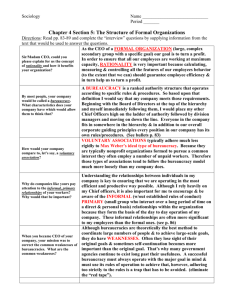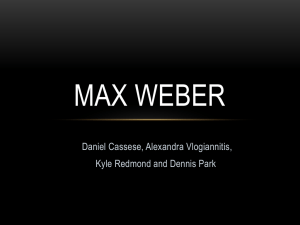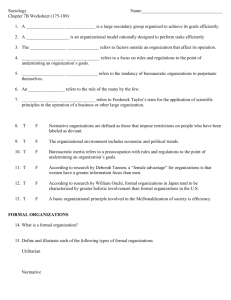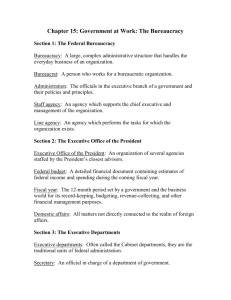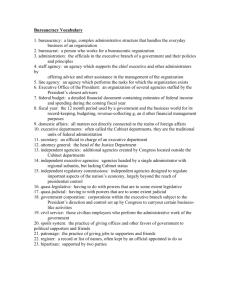8. Organization Structure, Culture, and Change.
advertisement
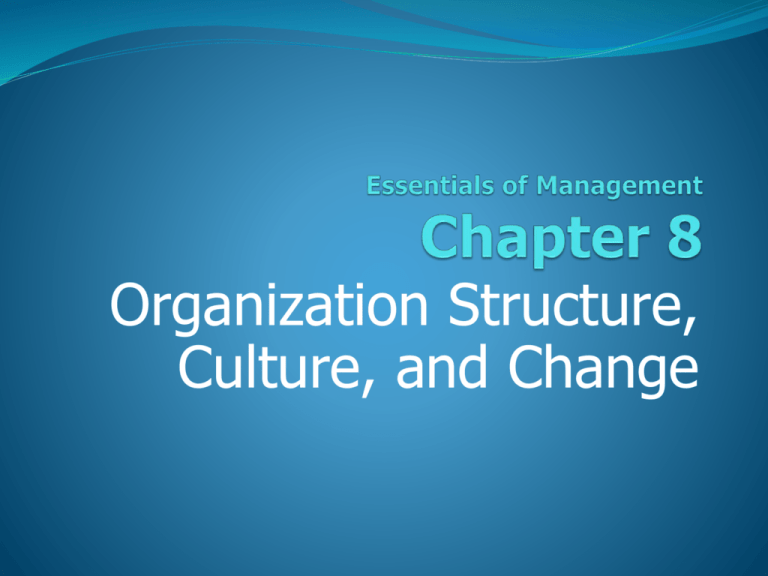
Organization Structure, Culture, and Change Introductory Concepts Chapter 8 describes a variety of approaches to subdividing work at the organizational and unit levels. Structure is the hard side of organizations. Culture and change are the soft side of organizations. Topics of structure, culture, and change are vital to understanding organizations. Principles of Organization in a Bureaucracy 1. 2. 3. Hierarchy of authority (organizational units controlled by a higher one) Unity of command (subordinates receive assigned duties from one superior, and only accountable to that superior) Task specialization (each organizational unit and each employee concentrates on one function) Principles of Organization in a Bureaucracy, continued 4. 5. Responsibilities and job descriptions (each employee has precise job description; policy and procedure manuals kept current and accessible) Line and staff functions (line deal with primary outputs of firm, staff deals with support activities, and advise line units) Advantages of a Bureaucracy Allows for high level of accomplishment. Workers know who is responsible for what, and whether they have the authority to make a given decision. Facilitates vertical integration, allowing for control of product development, manufacturing, and distribution. Prevents problem of workers not having enough direction. Disadvantages of a Bureaucracy Can be rigid in handling people and problems. Rules and regulations can lead to inefficiency, such as getting approvals. High frustration often caused by red tape (tight procedures that must be followed). Slow decision making because layers of approval are necessary. Functional Departmentalization Departments are defined by functions each one performs (e.g., accounting). Well suited for large-batch processing and for specialization. Can have problems due to its size and complexity. People within unit may not communicate well with workers in other units (functional silo problem). Geographic Departmentalization Departments are arranged according to geographic area or territory served. A natural unit in global business, such as Honda of America. Allows for decision making at local level. Can lead to high costs because of duplication of effort, and management may not be able to control local units well. Product-Service Departmentalization Departments arranged according to products or services they provide. Makes most sense when product or service has own unique demands. In well-run firm, units cooperate for mutual benefit. Some problems with duplication of effort, and control of separate units. Modifications of the Bureaucratic Organization Project and Matrix Organization Flat Structures, Downsizing, Outsourcing Horizontal Structure (Organization by Team and Process) Informal Structures and Communication Networks Power Sharing (Chairman and CEO) Selection of an Organization Structure Project and Matrix Organization Projects good for performing special tasks involving multiple specialties. Matrix organization is project structure superimposed on functional structure. Capitalizes on advantages of both. Big projects function as mini-companies. Project managers borrow resources from functional departments. Flat Structures Organization with many layers is sometimes converted to flat structure. Less bureaucratic because fewer managers review work of others. Wider span of control because managers now have fewer direct reports. IT a force for flatter structures. Flat structures can eliminate too many managers needed for decision making. Downsizing Can lead to simplified, less bureaucratic structure, better profits and stock prices. Can backfire with lowered morale and return on assets. Effective downsizing: (a) make it part of business strategy, (b) eliminate low-value work, (c) link to future work needs, (d) lay off sensibly, (e) help laid off workers, and (f) involve employees in resizing process. Outsourcing Part of globalization, but also having work performed by other organizations. Company can operate with fewer employees and physical assets, focus on activities it performs best. Both basic and more advanced business functions can be outsourced. Homeshoring moves customer service activities into homes of telecommuters. Horizontal Structure (Organization by Team and Process) Group of people is concerned with a process such as order fulfillment. Instead of task focus, all workers focus on purpose of the activity. Horizontal structure uses teams responsible for accomplishing a process. Reengineering switches emphasis from task to process. Caution—expertise is still important. Informal Structures and Communication Networks Informal structure supplements formal structure by adding flexibility and speed. Also referred to as informal networks because of focus on using personal contacts to obtain information. Social network analysis maps and measures links throughout organization. Nodes are people, links are relationships. Power Sharing at Highest Level of Management Concerns about complexity of top job has led to (a) splitting roles of chairman and CEO, and (b) use of co-CEOs. One person as chairman and CEO could lead to unchecked power. When CEO focuses on operations, chairperson can focus on strategy. Co-CEO arrangement better for family business than large, public company. Key Factors that Influence Selection of Organization Structure 1. 2. 3. 4. 5. Strategy and goals—structure follows strategy. Technology—high technology firms rely more on flexible structures. Size—bigness leads to centralized controls and some formalization. Financial condition—flat costs less. Environmental stability—flexible structure for unstable environment. Delegation of Responsibility and Empowerment a. b. c. d. e. To delegate and empower effectively, manager should: Assign duties to right people. Delegate whole task, avoid details. Give as much instruction as needed. Retain some important tasks. Obtain feedback on the delegated task. Decentralization Refers to passing authority to lower levels, as opposed to centralization. Favored when key decisions are made low in management hierarchy. Centralized firm exercises more control than does decentralized firm. Advanced technique is for decentralized units to be autonomous yet cooperate for common good. Determinants of Organizational Culture Origins could lie in values, administrative practices, and personality of founder. Culture mirrors choices, behavior, and prejudices of top-level managers. Society influences organizational culture. Industry in which firm operates can be influential, such as steel mill versus investment bank. Dimensions of Organizational Culture Values (almost synonymous with culture) Relative diversity of members Resource allocation and rewards (which behavior or units gets the most) Degree of change (stable versus rapidly changing) Sense of ownership (of workers) Strength of culture (extent of impact) How Workers Learn the Culture Socialization is major approach. Contacts with others lead to understanding values, norms, and customs essential for adapting to the organization. Teachings of leaders can also help impart culture to organizational members. Consequences and Implications of Organizational Culture Competitive advantage and financial success Productivity, quality, and morale Innovation (culture of innovation) Compatibility of mergers and acquisitions Person-organization fit (fitting the firm) Direction of leadership activity (points leader toward what needs to be done) Managing and Sustaining the Culture a. b. c. d. e. Managers bring about culture change by Being a role model for change. Using rewards to reinforce the culture Selecting people with values that match the culture Sponsoring training in support of culture Disseminating type of change required Creating Change at Individual versus Organizational Level Many useful changes take place at individual and small group level, rather than organizational level. “Movers and shakers” seek results rather than to avoid offending people. Organizational level change is change in fundamental way company operates. All employees must be eager for change. Unfreezing-Changing-Refreezing Model of Change Unfreezing is reducing or eliminating resistance to change. Changing or moving to a new level involves considerable two-way communication including group discussion. Refreezing includes rewarding people for implementing the change. Resistance to Change Fear of an unfavorable outcome. Not wanting to break old habits. Concern about upsetting balance of an activity, such as in-person contact. Desire to cling to the old, however flawed. Awareness of the weakness of a proposed change. Resistance can be feedback from workers about potential problems. Gaining Support for Change 1. 2. 3. 4. 5. 6. 7. 8. Allow for discussion and negotiation. Allow for participation. Point to reasons for, including finances. Establish sense of urgency. Use a visual people can relate to. Avoid change overload. Allow for first-hand observation of change. Get best people behind program. Six Sigma and Planned Change Shift to quality-conscious firm is total systems approach to change. Six Sigma can means (a) 3.4 errors in 1 million opportunities, (b) philosophy of driving out waste and improving quality, and (c) data-driven method for achieving near-perfect quality with emphasis on preventing problems. To work well, Six Sigma must fit culture.

